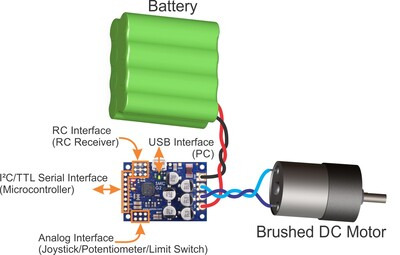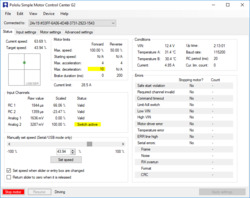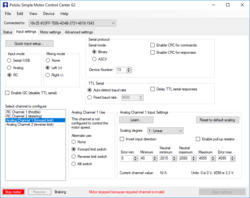Support » Pololu Simple Motor Controller G2 User’s Guide »
1. Overview
- 1.1. 18v15 and 24v12 included hardware
- 1.2. 18v25 and 24v19 included hardware
- 1.3. Supported operating systems
- 1.4. Comparison to the original Simple Motor Controllers
 |
Side-by-side comparison of the different G2 Simple Motor Controllers. |
|---|
The second-generation G2 Simple Motor Controllers are versatile, general-purpose motor controllers for brushed, DC motors. Wide operating voltage ranges and the ability to deliver up to several hundred Watts in a small form factor make these controllers suitable for many motor control applications. With a variety of supported interfaces—USB for direct connection to a computer, TTL serial and I²C for use with embedded systems, RC hobby servo pulses for use as an RC-controlled electronic speed control (ESC), and analog voltages for use with a potentiometer or analog joystick—and a wide array of configurable settings, these motor controllers make it easy to add basic control of brushed DC motors to a variety of projects. A free configuration utility for Windows simplifies initial setup of the device and allows for in-system testing and monitoring of the controller via USB.
The table below lists the members of the Simple Motor Controller G2 family and shows the key differences among them:
 18v15 |
 24v12 |
 18v25 |
 24v19 |
|
|---|---|---|---|---|
| Minimum operating voltage: |
6.5 V | 6.5 V | 6.5 V | 6.5 V |
| Recommended max operating voltage: |
24 V(1) | 34 V(2) | 24 V(1) | 34 V(2) |
| Max nominal battery voltage: |
18 V | 28 V | 18 V | 28 V |
| Max continuous current (no additional cooling): |
15 A | 12 A | 25 A | 19 A |
| Dimensions: | 2.1″ × 1.1″ | 1.7″ × 1.2″ | ||
| Available with connectors installed? |
Yes | Yes | No | No |
1 30 V absolute max.
2 40 V absolute max.
 |
High-Power Simple Motor Controller G2 18v25 or 24v19 simplified connection diagram. |
|---|
Key features
- Simple bidirectional control of one DC brush motor.
- Five communication or control options:
- USB interface for direct connection to a PC.
- Logic-level (TTL) serial interface for use with a microcontroller.
- I²C interface for use with a microcontroller.
- Hobby radio control (RC) pulse width interface for direct connection to an RC receiver or RC servo controller.
- 0 V to 3.3 V analog voltage interface for direct connection to potentiometers and analog joysticks.
- Simple configuration and calibration over USB with a free configuration program for Windows
- Reverse-voltage protection
- Hardware current limiting with a configurable threshold
- Current sensing
Note: A USB A to Micro-B cable (not included) is required to connect this controller to a computer.
Additional features
- Adjustable maximum acceleration and deceleration to limit electrical and mechanical stress on the system.
- Adjustable starting speed and maximum speed.
- Option to brake or coast when speed is zero.
- Optional safety controls to avoid unexpectedly powering the motor.
- Input calibration (learning) and adjustable scaling degree for analog and RC signals.
- Under-voltage shutoff with hysteresis for use with batteries vulnerable to over-discharging (e.g. LiPo cells).
- Adjustable over-temperature threshold and response.
- Adjustable PWM frequency from 1.13 kHz to 22.5 kHz (maximum frequency is ultrasonic, eliminating switching-induced audible motor shaft vibration).
- Error LED linked to a digital ERR output, and connecting the error outputs of multiple controllers together optionally causes all connected controllers to shut down when any one of them experiences an error.
- Field-upgradeable firmware.
|
|
- Features of the serial, I²C, and USB interfaces:
- Optional CRC error detection to eliminate communication errors caused by noise or software faults.
- Optional command timeout (shut off motors if communication ceases).
- Serial features:
- Controllable from a computer via serial commands sent to the device’s USB virtual serial (COM) port, or via TTL serial through the device’s RX/TX pins.
- TTL serial uses 0 V and 3.3 V on TX, accepts 0 V to 5 V on RX.
- Supports automatic baud rate detection from 1200 bps to 500 kbps, or can be configured to run at a fixed baud rate.
- Supports standard compact and Pololu protocols as well as the Scott Edwards Mini SSC protocol and an ASCII protocol for simple serial control from a terminal program.
- Optional serial response delay for communicating with half-duplex controllers such as the Basic Stamp.
- Controllers can be easily chained together and to other Pololu serial motor and servo controllers to control hundreds of motors using a single serial line.
- I²C features:
- Compatible with I²C bus voltage levels from 1.8 V to 5 V.
- USB features:
- Full-speed USB interface (12 Mbps)
- Example code in C#, Visual Basic .NET, and Visual C++ is available in the Pololu USB Software Development Kit
- RC features:
- 1/4 µs pulse measurement resolution.
- Works with RC pulse frequencies from 10 to 333 Hz.
- Configurable parameters for determining what constitutes an acceptable RC signal.
- Two RC channels allow for single-stick (mixed) motor control, making it easy to use two simple motor controllers in tandem on an RC-controlled differential-drive robot.
- RC channels can be used in any mode as limit or kill switches (e.g. use an RC receiver to trigger a kill switch on your autonomous robot).
- Battery elimination circuit (BEC) jumper can power the RC receiver with 5 V or 3.3 V.
- Analog features:
- 0.8 mV (12-bit) measurement resolution.
- Works with 0 to 3.3 V inputs.
- Optional potentiometer/joystick disconnect detection.
- Two analog channels allow for single-stick (mixed) motor control, making it easy to use two simple motor controllers in tandem on a joystick-controlled differential-drive robot.
- Analog channels can be used in any mode as limit or kill switches.
Note: This guide only applies to the G2 Simple Motor Controllers, which have blue circuit boards. If you have one of the first-generation Simple Motor Controllers, which have green circuit boards, you can find their user’s guide here.
Warning: Take proper safety precautions when using high-power electronics. Make sure you know what you are doing when using high voltages or currents! During normal operation, this product can get hot enough to burn you. Take care when handling this product or other components connected to it.










